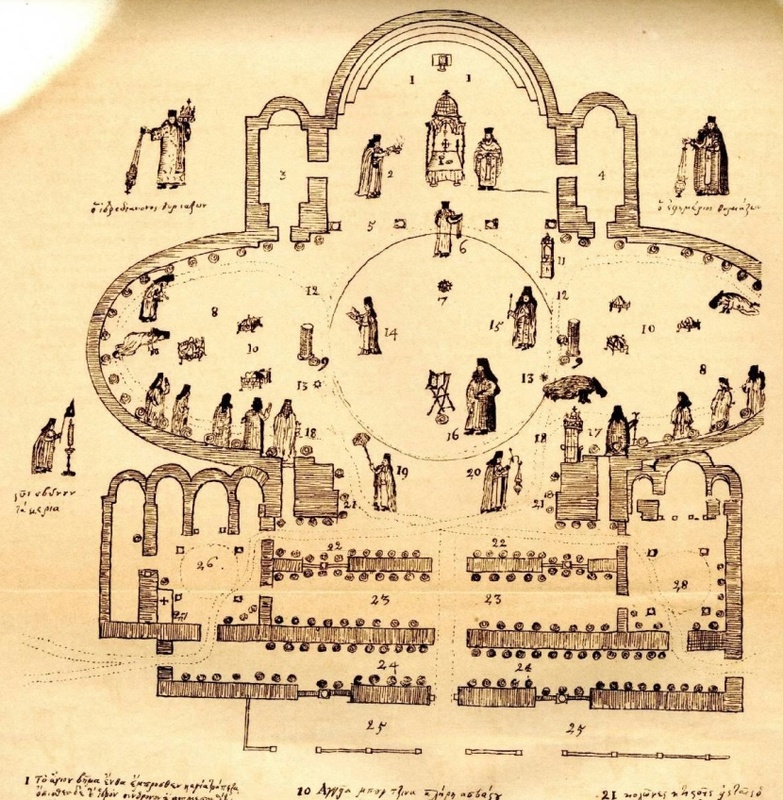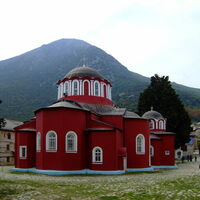Great Lavra on Mount Athos
Type:
Churches,
Monasteries
Date:
963 and later
Location or Findspot (Modern-Day Country):
Greece
Description:
The Great Lavra, founded in 963, was the second monastery built on Mount Athos, a peninsula in northeastern Greece known as the Holy Mountain because of its concentration of Orthodox monasteries (now twenty in total, but once many more). Access to Mount Athos has always been restricted to men, although a few women are known to have visited. It remains a site of prayer and pilgrimage today.
A lavra is a type of monastery in which the monks pray and work independently but gather together for meals. Despite its name, however, the Great Lavra was always a communal, cenobitic monastery. Its founder, a monk named Athanasios, dedicated it to the Theotokos, but it was later rededicated to the sainted Athanasios himself. The typikon permitted 80 monks, but in the eleventh century there were 700.
The fortresslike monastery is surrounded by walls and towers. Inside are dozens of chapels in addition to the domed katholikon. The church was originally a cross-in-square, but around 1000 it was enlarged with side apses (choroi) and assumed a triconch plan. The choroi permitted groups of monks to chant the monastic liturgies across the space. As with Byzantine churches elsewhere, additional chapels proliferated, first flanking the narthex (one contained the tomb of Athanasios); eventually an outer narthex (exonarthex) was added.
The Lavra's triconch plan was the model for all the later Athonite churches and was exported beyond the Holy Mountain to Orthodox churches across northern Greece and the Balkans. Vasilij Grigorovich Barskij, a Russian Orthodox traveler, drew a plan of liturgical activities happening in the katholikon in 1744.
Initial funding for the Great Lavra came from the general and future emperor Nikephoros II Phokas (r. 963–69); when he became emperor, it became an imperial monastery independent of ecclesiastical authorities. The Mount Athos monasteries were later supported not only by the Byzantine emperors but also, and especially, by rulers of neighboring polities, including Bulgaria, Serbia, Georgia, Rus', and Albania, who all favored particular national or ethnic foundations. In the 1420s, the monasteries submitted to the Ottoman sultan to ensure that they would not be pillaged.
A lavra is a type of monastery in which the monks pray and work independently but gather together for meals. Despite its name, however, the Great Lavra was always a communal, cenobitic monastery. Its founder, a monk named Athanasios, dedicated it to the Theotokos, but it was later rededicated to the sainted Athanasios himself. The typikon permitted 80 monks, but in the eleventh century there were 700.
The fortresslike monastery is surrounded by walls and towers. Inside are dozens of chapels in addition to the domed katholikon. The church was originally a cross-in-square, but around 1000 it was enlarged with side apses (choroi) and assumed a triconch plan. The choroi permitted groups of monks to chant the monastic liturgies across the space. As with Byzantine churches elsewhere, additional chapels proliferated, first flanking the narthex (one contained the tomb of Athanasios); eventually an outer narthex (exonarthex) was added.
The Lavra's triconch plan was the model for all the later Athonite churches and was exported beyond the Holy Mountain to Orthodox churches across northern Greece and the Balkans. Vasilij Grigorovich Barskij, a Russian Orthodox traveler, drew a plan of liturgical activities happening in the katholikon in 1744.
Initial funding for the Great Lavra came from the general and future emperor Nikephoros II Phokas (r. 963–69); when he became emperor, it became an imperial monastery independent of ecclesiastical authorities. The Mount Athos monasteries were later supported not only by the Byzantine emperors but also, and especially, by rulers of neighboring polities, including Bulgaria, Serbia, Georgia, Rus', and Albania, who all favored particular national or ethnic foundations. In the 1420s, the monasteries submitted to the Ottoman sultan to ensure that they would not be pillaged.
Relevant Textbook Chapter(s):
6
Repository and Online Resources:
• See plans of today's Great Lavra and its katholikon (© Robert Ousterhout) on the Smarthistory website (click at the end of Triconch Churches).
• Watch a movie about life on Mount Athos.



